Ah, sleep, the envy of those who can’t get it, and a rich reward for those who can. When we think about sleep, we usually imagine a luxurious bed, some soothing music, and comfortable pillows to help us fall into horizontal slumber. It may surprise you then to know that, in the animal kingdom, there are a variety of species that often sleep standing up! Aside from astronauts in zero gravity cots fastened to walls, there aren’t many humans that can make the same claim. So, today let’s figure out how sleeping while standing is even possible, peek at 17 animals that can sleep standing up and explore some of the reasons why they’ve adapted to do so.
How Do Animals Sleep Standing Up?

Horses famously can sleep standing up
©Lioneska/Shutterstock.com
In order to sleep standing up, all of the animals listed below have developed unique adaptations. The details vary from species to species but generally involve one or more of the following: a stay apparatus, gravity manipulation, or a flexor tendon. Let’s take a quick look at what those adaptations are and how they work.
The Stay Apparatus
The stay apparatus is a series of muscles, ligaments, and tendons that lock the limbs of a large herbivore in place, allowing it to “stay” in a standing position. By locking the major joints, the herbivore can relax the rest of their muscles and enter light sleep. This apparatus is common across quite a few species.
Gravity Manipulation
Gravity is a powerful force, and fighting it can take a lot of energy. A few species of birds have managed to find a loophole, using gravity strategically when they sleep. These birds sleep on one leg, placed directly beneath their center of mass, which changes their balance and localizes gravitational pressure. The localized downward pressure locks their ankle joints in place to keep them upright. Simply put, these birds created a pressure lock by using gravitational forces.
Flexor Tendons
Many other birds can also sleep standing up using something called a flexor tendon. There are usually two flexor tendons extending down the back of a bird’s legs to the toes and tightens when they land on a perch. It is an involuntary reflex. The tendons release when the bird extends its legs, but as long as it is stationary, the tendons tighten, providing enough rigidity to allow the bird to fall asleep while standing.
Animals that can Sleep Standing Up
According to multiple accounts and observations, the following five animals can sleep standing up and do so regularly. See if any of the names surprise you!
Horses
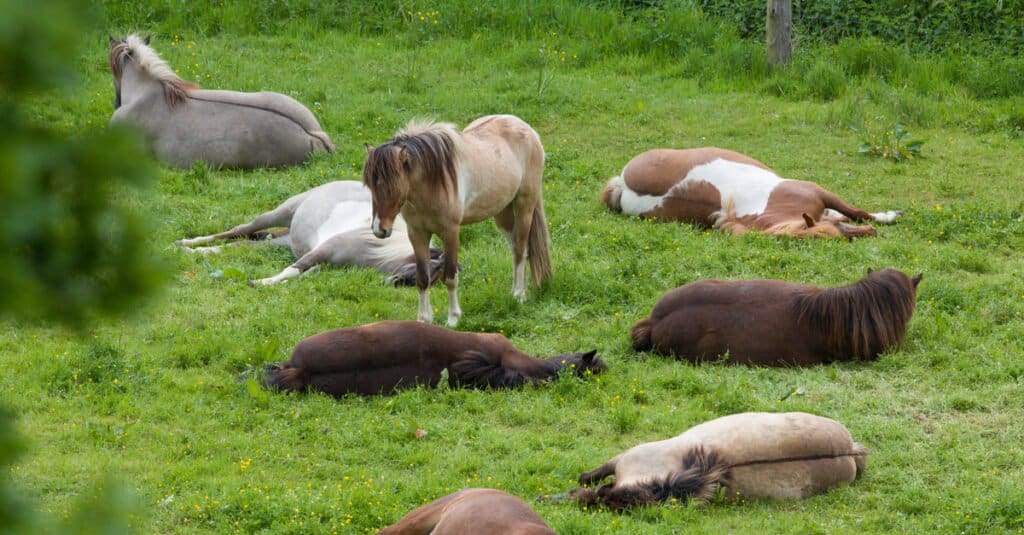
Horses will power nap while standing but lie down for deeper rests
©malafo/Shutterstock.com
Horses are perhaps the most well-known animal species to use a stay apparatus, allowing them to nod off into a light vertical sleep. This does not mean the horse sleeps all night like this. During slow-wave and REM (rapid eye movement) sleep, the horse has to lie down because its muscles, joints, tendons, and ligaments will be in a state of weakness (atony) that no stay apparatus can prop up. The stay apparatus is, therefore, used more like a power nap enabler than a mechanism to allow for a full night’s sleep.
Elephants
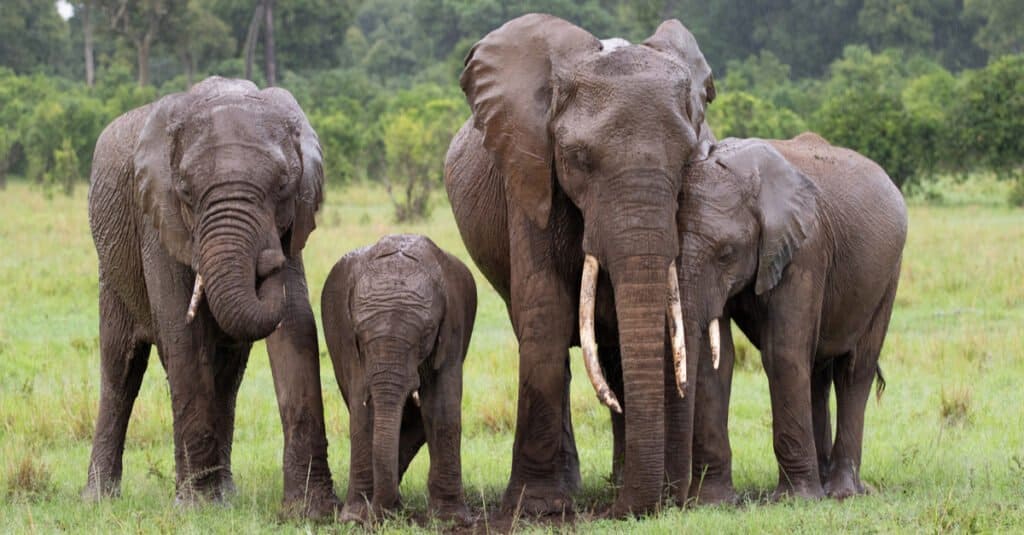
Elephants only sleep two hours per day in the wild
©Neil Tyers/Shutterstock.com
Elephants have peculiar sleep habits. Those in captivity tend to sleep four-six hours a day, while those observed in the wild can function on only two hours of sleep a day. Domesticated elephants tend to sleep more lying down, while wild elephants prefer to sleep standing up. The difference is likely due to the long, cumbersome process of waking up from a horizontal position, which leaves the elephant vulnerable to threats in the wild. Domesticated elephants don’t really deal with many life/death situations, so the need to sleep standing up lessens.
Giraffes
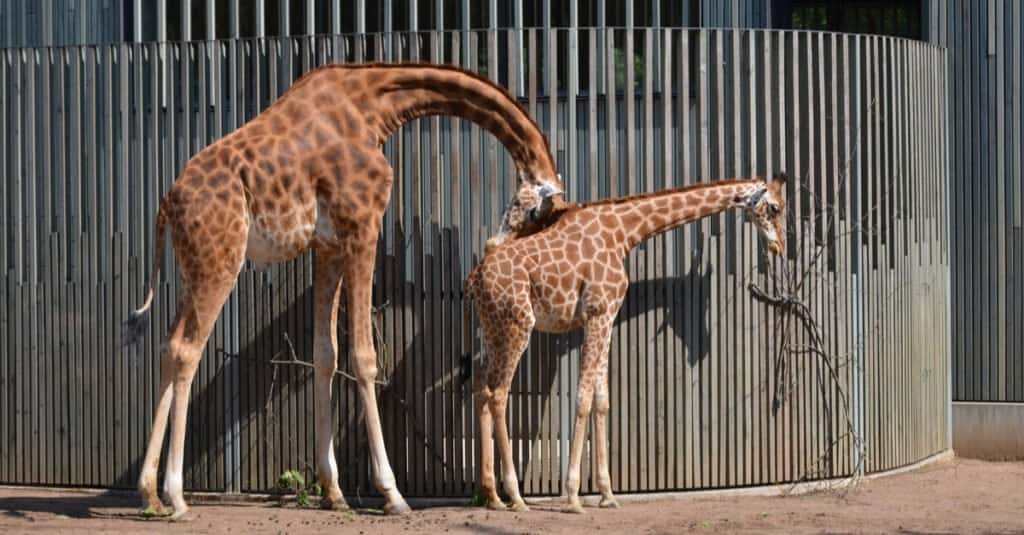
Giraffes are another species that sleeps very little
©umat34/Shutterstock.com
Giraffes, like elephants, require very little sleep. A common adult giraffe averages one to two hours of sleep a day but never in one cycle. In fact, the average giraffe power nap only lasts between two and ten minutes! With such a rapid cycle, it makes sense that giraffes would find the ability to sleep standing up useful. For the world’s tallest living animal to lie down, only to get back up after ten minutes, constitutes a colossal waste of energy. Since predation is a concern in the savanna, where they live, their standing nap cycles provide them with the best chance to wake quickly and escape a stalking predator.
Flamingos
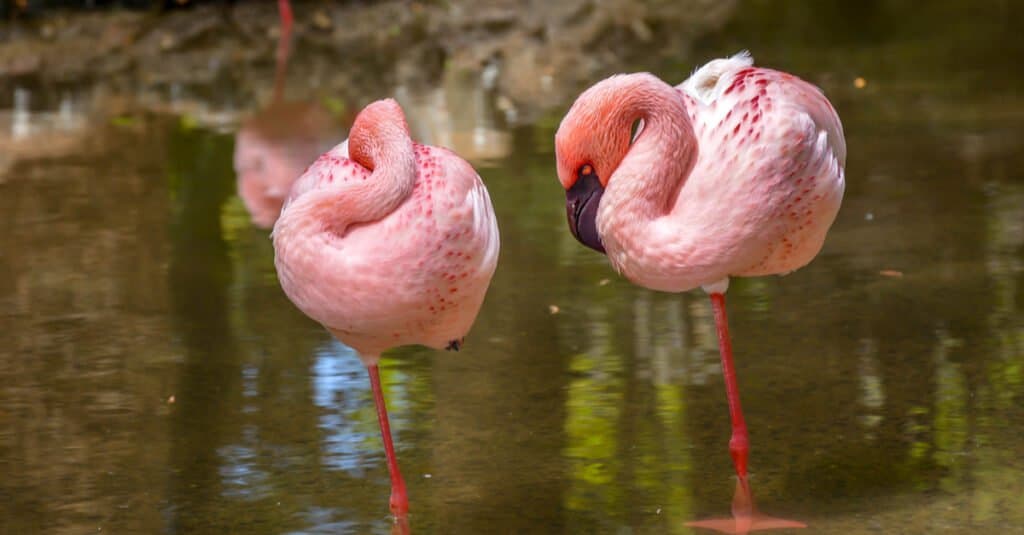
Flamingos
use gravity to their advantage when sleeping on one leg
©IndreJeg/Shutterstock.com
Masters of the gravity manipulation strategy, flamingos can sleep and stand for long periods of time on only one leg, which uses much less muscle activity than standing on two legs. When their body is supported by one leg, the flamingos weight forces the ankle joint of the extended leg (located where you think its knee would be) to lock into position. Researchers in 2017 confirmed this by running a series of experiments on both live and recently deceased flamingos. Perhaps the most shocking discovery was that the researchers could prompt the locking mechanism of the recently deceased flamingos and have them stand in place without falling over, which is crazy!
Crows (Passeriformes)
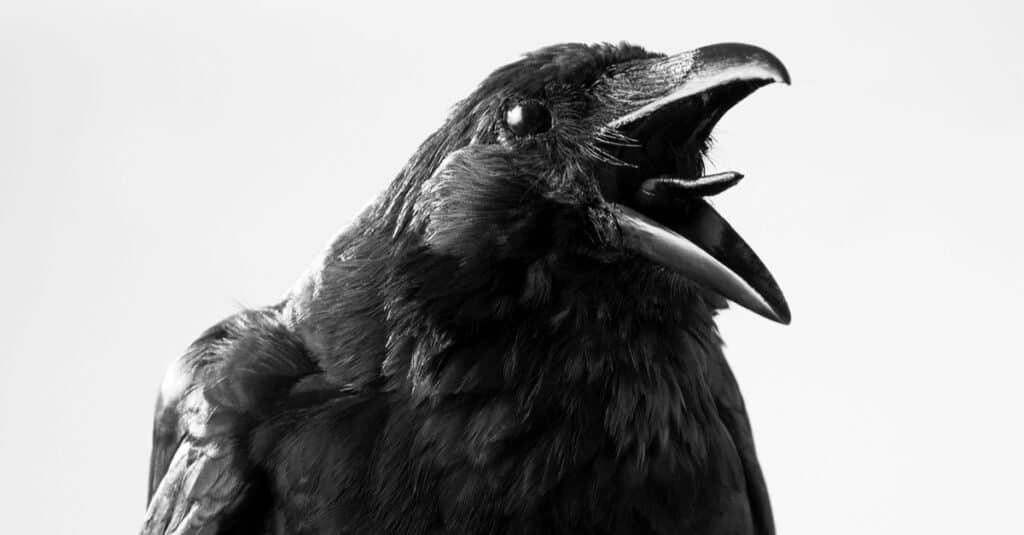
Crows can sleep standing up thanks to adaptations in their flexor tendons
©redpip1984/Shutterstock.com
Crows are fascinating creatures; they have memories, understand causality on par with a 7-year-old human, learn from their environments, and can even hold grudges! Since they belong to the order Passeriformes (which encompasses more than half of the world’s birds), crows also come with flexor tendons. The flexor tendons allow crows to sleep standing up for longer periods of time than horses, elephants, and giraffes. In addition to crows, other common birds like pigeons, quails, and canaries belong to this order.
Why do Animals Sleep Standing Up?
There are a few reasons why an animal would choose to sleep standing up. Perhaps the most pressing one would be the threat of predation. The act of rising from horizontal sleep is time-consuming and leaves a window open for predators to take advantage of groggy prey. By sleeping standing up, herbivores give themselves the best chance for survival.
For giraffes and horses, there is a distinct digestive advantage as well. Digestion in large herbivores takes time and is a labor-intensive process. Sleeping while standing allows the digestive process to continue while the animal rests.
For some animals, less effort is key. The flamingo’s gravity manipulation allows it to use the least amount of energy possible. Efficiency fuels adaptation, and in the case of the flamingo, it’s easiest to sleep standing up on one leg. Another reason flamingo’s may have adapted to sleep standing up is their environment. The birds live largely in caustic salt flats, which are toxic. A flamingo’s long legs allow its vital organs to remain suspended over the ground in a much safer space than lying down.
Can humans sleep standing up?
Unfortunately, we don’t have any kind of stay apparatus or the ability to shift in a way that minimizes gravitational forces acting upon us. That doesn’t mean you can’t fall asleep standing up, but if you do, any outside force or relaxation of the muscles will send your body tumbling back to the ground. Save yourself the experiment and sleep in a comfy bed.
A List of 17 Animals That Can Sleep Standing Up
In addition to the five listed above, numerous additional animals have the ability to sleep standing up. Here are 17 examples of animals that sleep while standing:
| Name | Type of Animal |
|---|---|
| Camels | Mammal |
| Cranes | Bird |
| Cows | Mammal |
| Deer | Mammal |
| Donkeys | Mammal |
| Ducks | Bird |
| Gazelles | Mammal |
| Geese | Bird |
| Songbirds | Bird |
| Storks | Bird |
| Rhinos | Mammal |
| Zebras | Mammal |
| Horses | Mammal |
| Elephants | Mammal |
| Giraffes | Mammal |
| Flamingos | Bird |
| Crows | Bird |
Bonus: What Animals Sleep 75% of Their Lives?

Little Brown Bats sleep for an average of 20 hours per day to conserve energy.
©Ondrej Prosicky/Shutterstock.com
While some animals we’ve looked at sleep standing up, there are others that just sleep–period! In fact, there are several animals that sleep the majority of their lives away. Animals that sleep a large percentage of their lives include:
- Brown Bats–They sleep an average of 19.9 hours a day, or 82.9% of 24 hours
- Giant Armadillo–They sleep 18.1 hours a day, or 75.4% of 24 hours
- North American Opossum–They sleep 18 hours a day, or 75% of 24 hours
- Python–They sleep 18 hours a day, or 75% of 24 hours
Other animals that spend a little too much time snoozing are: owl monkey, squirrel, tree shrew, western toad, tiger, ferret, and three-toed sloth.
The photo featured at the top of this post is © umat34/Shutterstock.com
Thank you for reading! Have some feedback for us? Contact the AZ Animals editorial team.






